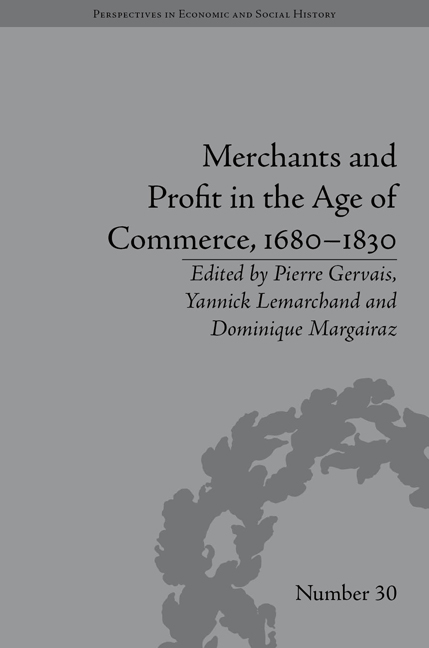Book contents
- Frontmatter
- CONTENTS
- Acknowledgements
- List of Contributors
- List of Figures and Tables
- Introduction: The Many Scales of Merchant Profit: Accounting for Norms, Practices and Results in the Age of Commerce
- Part I Understanding Merchant Transactions
- Part II The Credit Nexus and its Pitfalls
- Part III Beyond Price Signals: The Institutional Framework
- Part IV Diversification and Risk Management
- 7 The Pinet Family of Gap and their Business Relations, 1785–1816: Official Activities and the Issue of Commercial Risk
- 8 ‘The Way to Make a Huge Fortune, Easily and Without Risk’: Economic Strategy and Tactics among Tobacco-South Planters in the Early National United States
- Conclusion: Reorienting Early Modern Economic History: Merchant Economy, Merchant Capitalism and the Age of Commerce
- Notes
- Index
7 - The Pinet Family of Gap and their Business Relations, 1785–1816: Official Activities and the Issue of Commercial Risk
from Part IV - Diversification and Risk Management
- Frontmatter
- CONTENTS
- Acknowledgements
- List of Contributors
- List of Figures and Tables
- Introduction: The Many Scales of Merchant Profit: Accounting for Norms, Practices and Results in the Age of Commerce
- Part I Understanding Merchant Transactions
- Part II The Credit Nexus and its Pitfalls
- Part III Beyond Price Signals: The Institutional Framework
- Part IV Diversification and Risk Management
- 7 The Pinet Family of Gap and their Business Relations, 1785–1816: Official Activities and the Issue of Commercial Risk
- 8 ‘The Way to Make a Huge Fortune, Easily and Without Risk’: Economic Strategy and Tactics among Tobacco-South Planters in the Early National United States
- Conclusion: Reorienting Early Modern Economic History: Merchant Economy, Merchant Capitalism and the Age of Commerce
- Notes
- Index
Summary
Introduction
From a classical and neo-classical point of view, the concept of risk is closely linked to that of profit, in the sense that taking a risk legitimizes economic profit as it is perceived by the entrepreneur. As David Hume wrote, ‘men must have profits proportion able to their expence and hazard’. The rational agent is thus supposed to engage in evaluating risks ahead of time, in order to invest if and only if the rates of profit vary in the same direction as the intensity of risks. Such a procedure can be envisioned only when it is possible to determine ahead of time the probability of an event – hence the necessity of introducing the distinction between risk and uncertainty proposed by Frank Knight. On the one hand, we would be dealing with predictable events, the probability of which could be expressed in quantified form after having been calculated. On the other hand, uncertainty would signify the opposite: that is, the impossibility of assigning a mathematical probability to any given event.
In the standard literature, the notion of risk reflects first of all a probabilistic grasp of the future, and secondly, a purely economic conception of profit and therefore of the notion of risk itself, in that this notion cannot be dissociated from that of profit.
- Type
- Chapter
- Information
- Merchants and Profit in the Age of Commerce, 1680–1830 , pp. 133 - 152Publisher: Pickering & ChattoFirst published in: 2014

